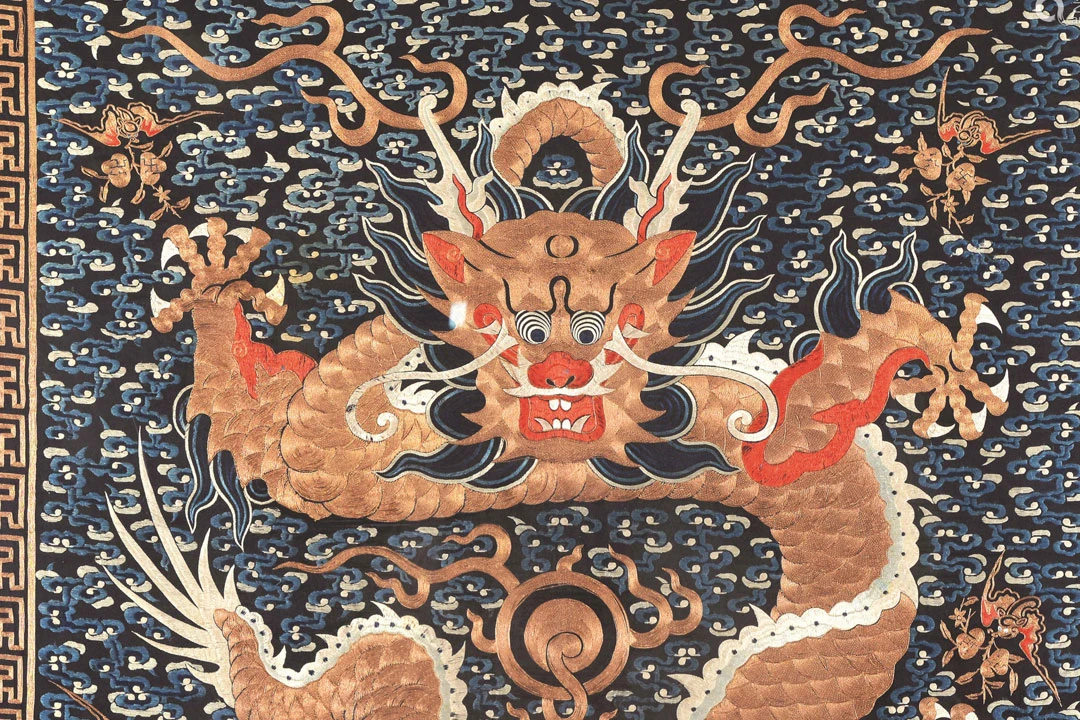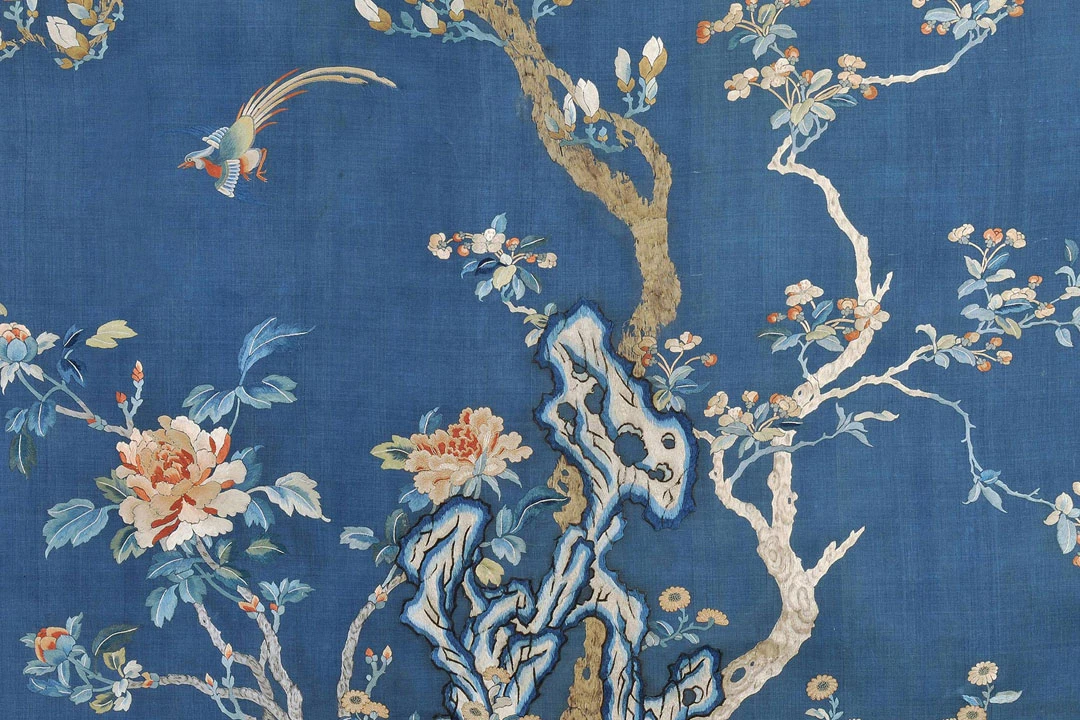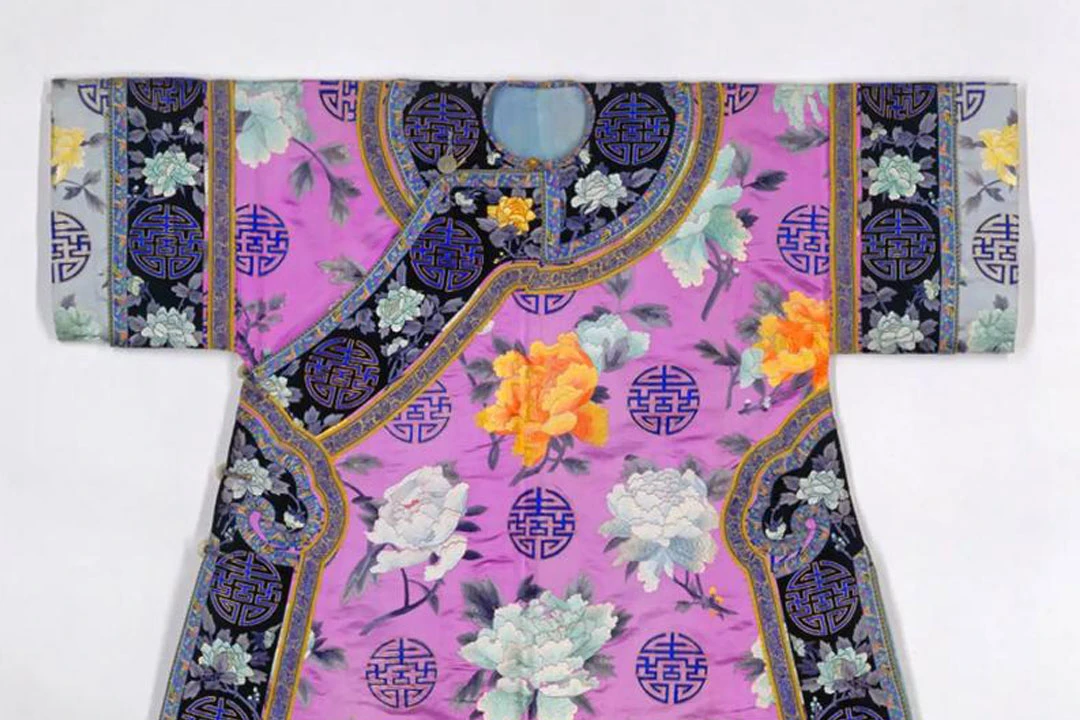Duration: June 21, 2024 - September 22, 2025
Location: Jiade Art Center
The exhibition titled "National Colors and Palace Splendor — Colors of Qing Dynasty Court Textiles" intricately weaves together the concepts of "采" (cǎi) and "彩" (cǎi), both of which historically denote multicolored silks and vibrant spirits. Through the tapestries, embroideries, and colors of Qing dynasty court garments, the exhibition aims to illuminate not only the visual grandeur but also the profound cultural and symbolic significance embedded in each fabric.
Patterns and Imperial Authority: A Cloak with Motifs
In Qing dynasty rule, while maintaining the Manchu ethnic identity through surnames, hairstyles, and clothing, the imperial court adopted Han Chinese motifs, symbols, and patterns. One remarkable piece on display is the Changfu with dragon motifs in various poses: frontal sitting dragons, walking dragons on all fours, and intertwined dragons forming floral patterns. These designs, meticulously carved like relief sculptures, exude a vibrant vitality akin to the famous Nine-Dragon Screen at the Palace Museum and Beihai Park in Beijing.
The Exhibition Sections
The exhibition unfolds through five thematic units: Celestial Elements, Majestic Illumination, Magnificent Sophistication, Seasonal Splendors, and Clouds of Elegance. Of particular interest is the "Seasonal Splendors" unit, showcasing garments such as the Moonlight Satin Chang with gold and silver embroidery depicting narcissus motifs and the Plain Red Feather Satin Chang without any motifs, both representing casual wear from the late Qing dynasty, which surprisingly overshadowed traditional court attire and dragon robes in fashion trends.
Imperial Garments and the Twelve Symbols
Central to the exhibition are the Twelve Symbols (Shí'èr zhāng) embroidered on imperial attire, each symbol representing a virtue or cosmic element vital to the emperor's role and responsibility. The motifs include the sun, moon, constellations, mountains, dragons, and various auspicious elements, signifying the emperor's divine mandate and moral authority over the realm. These symbols not only adorned ceremonial robes (Lǐfú) and dragon robes (Lóngpáo) but also reflected the emperor's highest virtues and ideals.
Imperial Significance and Cultural Symbolism
The Qing dynasty's imperial garments were not merely articles of clothing but profound statements of authority, virtue, and cosmic harmony. Central to this display are the "Twelve Symbols" (Shí'èr zhāng), which adorned the ceremonial robes and dragon robes of the emperors. These symbols, meticulously embroidered with gold and silver threads on silk fabrics, represented the emperor's mandate to govern with virtues akin to celestial bodies and natural elements.
Among the most iconic symbols were the sun and moon, representing illumination and cyclical renewal, respectively. The depiction of mountains symbolized stability and the emperor's role as a pillar of the state. Dragons, auspicious creatures in Chinese mythology, were intricately woven into the fabric to signify imperial power and the emperor's ability to transform and protect the realm. These symbols were not merely decorative but imbued with deep philosophical and moral meanings, reinforcing the emperor's divine mandate as the Son of Heaven.
Evolution of Court Attire: From Ritual to Fashion
The exhibition showcases a chronological evolution of Qing dynasty court attire, illustrating how fashion intertwined with ritualistic and cultural functions. Initially influenced by Manchu traditions, Qing court attire gradually absorbed Han Chinese elements, such as motifs depicting auspicious animals and symbolic patterns associated with longevity and prosperity.
One notable transition highlighted in the exhibition is the transformation of court garments from strictly ceremonial robes to more practical and fashionable attire. For instance, the exhibition features garments worn by Empress Dowager Cixi, known for her reformist approach to court dress. Her preference for elegant yet functional attire marked a departure from traditional extravagance towards a blend of aesthetic appeal and practicality.
Artistic Techniques and Mastery
The craftsmanship displayed in the exhibition exemplifies the pinnacle of Qing dynasty textile artistry. Embroiderers and weavers employed techniques such as flat embroidery (pǐn xiù), gold and silver thread work (jīn yín xiù), and intricate knotting (jié zhuāng) to create vivid depictions of dragons, mythical beasts, and auspicious symbols. Each garment tells a story not only of imperial splendor but also of the skilled artisans who painstakingly crafted these masterpieces.
Moreover, the use of vibrant colors and luxurious materials reflected the wealth and status of the Qing court. Fabrics like satin, brocade, and velvet were adorned with patterns inspired by nature, folklore, and historical events, showcasing the dynasty's rich cultural heritage and artistic innovation.
Legacy and Influence
Beyond their aesthetic appeal, Qing dynasty court textiles continue to inspire contemporary fashion and artistic expression. Their intricate designs and symbolic motifs resonate with themes of power, authority, and cultural identity. By exploring the exhibition "National Colors and Palace Splendor — Colors of Qing Dynasty Court Textiles," viewers gain a deeper appreciation for how textiles served as conduits of political ideology, cultural continuity, and artistic excellence throughout China's imperial history.



